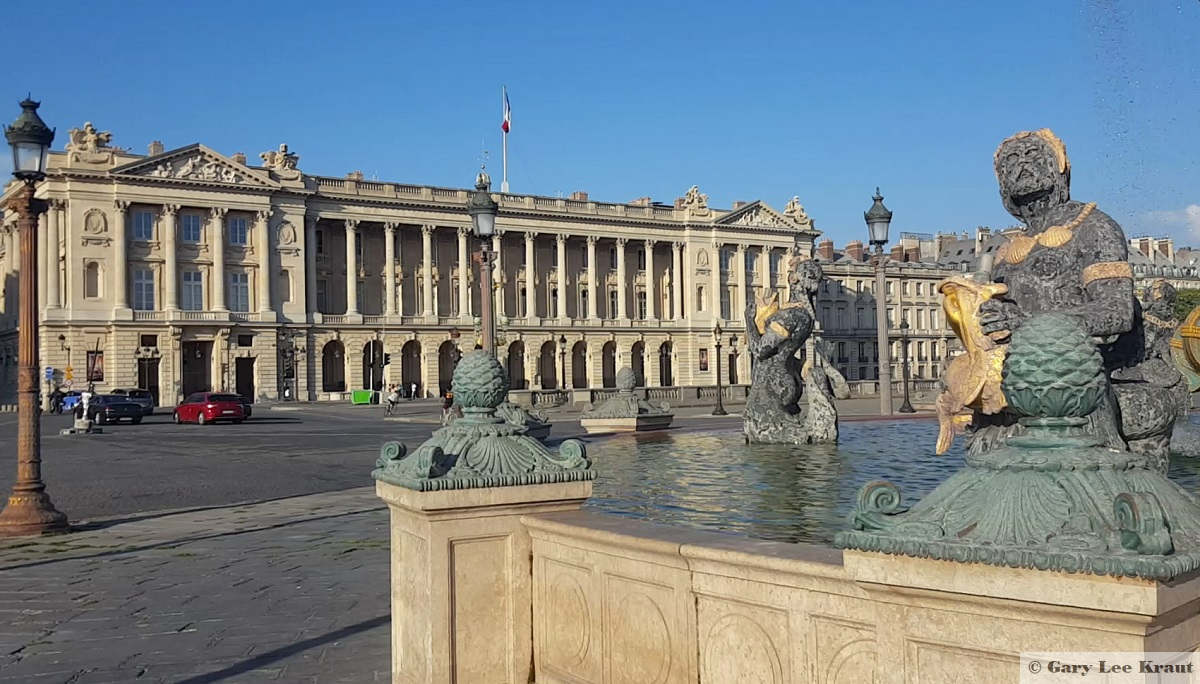
Six years after France’s Naval Ministry vacated its monumental headquarters in Paris facing Place de la Concorde, the public now has access to the Hôtel de la Marine—not a hotel for the lodging of travelers but a hôtel in the sense also used in French of an administrative building in a city. A museum portion presents a dozen painstakingly restored historic rooms and an impressive view out to the square, while the 18th-century building also houses a chic café, an upscale restaurant and a private art collection. Gary Lee Kraut and Corinne LaBalme visited the Hôtel de la Marine separately then teamed up to tell about this welcome addition to the museumscape of Paris. Photos and video by GLK.
For centuries until the French Revolution, the extension and beautification of Paris was largely a royal affair. Among the last major urban developments in the capital before titles and heads would fall was Place Louis XV, now called Place de la Concorde, Paris’s largest square, a nearly 20-acre zone between the Tuileries Garden and the Champs-Elysées.
In 1793, both Louis XVI and Marie-Antoinette would know the sharp edge of the guillotine on the square (renamed Place de la Révolution for the occasion), but 30 years earlier the Sixteenth’s predecessor and grandfather, Louis XV, arrived of his own free will to bask in royal veneration as he inaugurated a bronze equestrian statue in his honor. Facing the splendid royal city with calm strength and crowned with laurel leaves, the statue was the focal point around which western Paris would develop, beginning with this very square where two monumental palaces were then under construction.
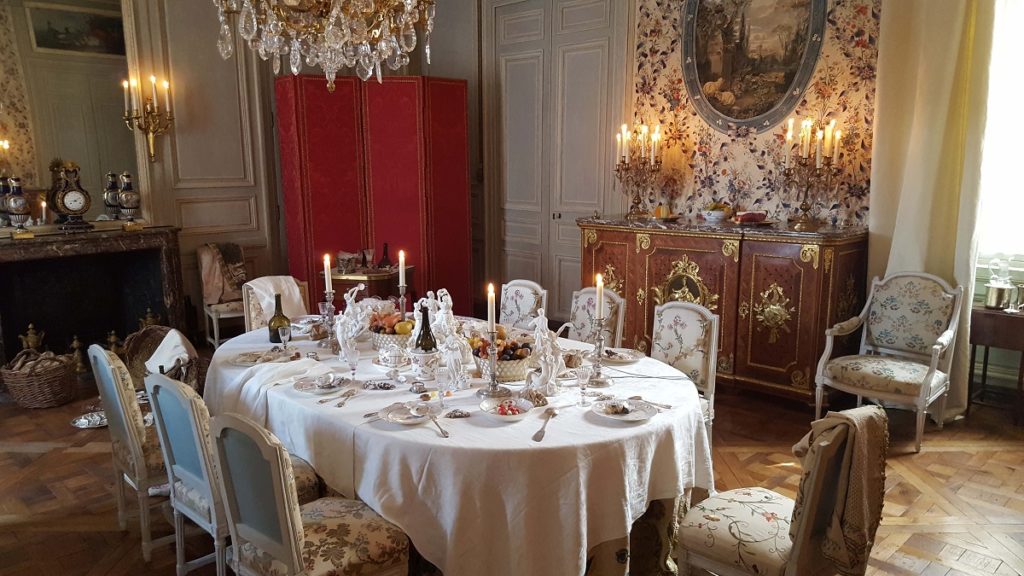
Ange-Jacques Gabriel, the star architect of the day, had been commissioned to create identical Neoclassical palaces to adorn the northern flank of the new square. These enormously expensive buildings, called hôtels in French, were not exactly purpose-built, beyond the purpose of creating an impressive backdrop for the aforesaid statue. (In French, a hôtel, in addition to designating a place of lodging, refers to a town house or city mansion or administrative building.)
The western building became a private residence. It is now partly occupied by the luxury hotel Le Crillon and the Automobile Club of France. Meanwhile, the eastern building was consigned in 1765 to the Garde-Meuble de la Couronne, an institution tasked with furnishing and maintaining the furnishings of royal palaces (Versailles, Compiègne, Fontainebleau, Rambouillet, Saint-Germain-en-Laye and others.) Think of it as the royal furniture storehouse, though it stored and ordered more than furniture. From beds and chairs to bronze clock, crown jewels, fancy firearms and linens, the Garde-Meuble oversaw the ordering and storage of all manner of decorative elements. Its head administrator or intendant was in contact with the major craftsmen and designers of the era, along with a substantial budget. (The Garde-Meuble is ancestor to the Mobilier National, which currently maintains and restores furnishings, ancient and contemporary, for official use by the State.)
Alas, it wasn’t exactly a secure location for national treasures: revolutionaries raided the royal arms collections on July 13, 1789 before heading to the Bastille the following day, and the crown jewels were stolen in 1792. But eventually there was enough calm in the air to optimistically rebaptize the square on which it stood Place de la Concorde.
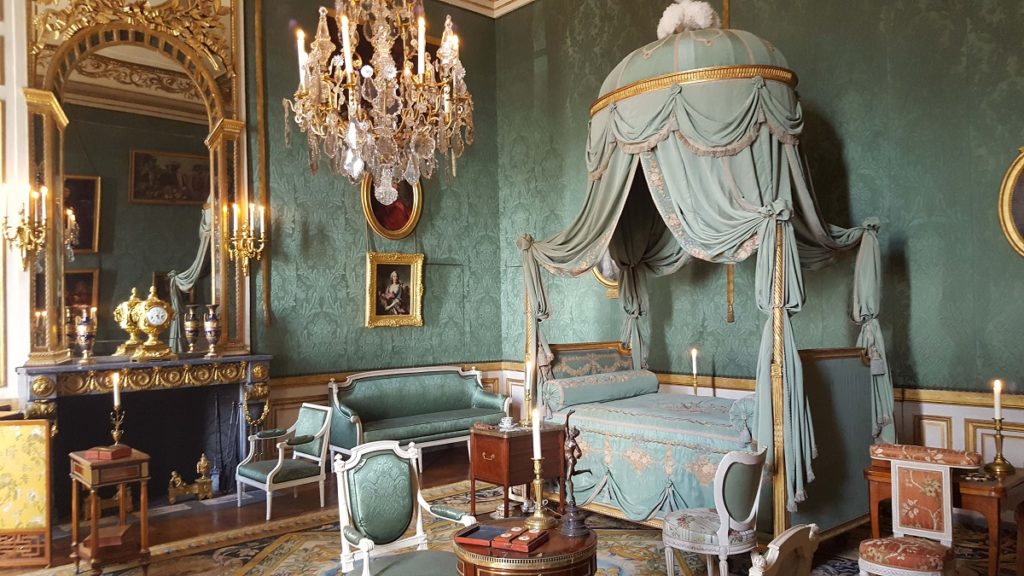
The French Naval Command began to use a portion of the Garde-Meuble during the Revolution, and by the of the 18th century it had taken over the entire premises, leading the building to be called Hôtel de la Marine. The Navy continued to occupy the building until 2015, when the military consolidated its branches in a new location in southern Paris. The destiny of the Hôtel de la Marine was then up for grabs.
There was no shortage of ideas on how to re-purpose this glorious chunk of central Paris real estate. What re-opened in June 2021, after four years of renovation, is a hybrid solution: a museum dedicated to the building’s first mission as the royal garde-meuble and its second as navy headquarters; an upscale café; a formal restaurant; a giftshop; an art gallery; the headquarters for two foundations, and several floors of co-working rental space.
Despite its name, the museum in the Hôtel de la Marine is not a pendant to the Museum of the Army at the Invalides. While there are traces of the naval presence—a gallery of “war ports” endowed by Napoleon III, the anchor motifs on ceiling fixtures—along with a tactile display telling about famous French marine officers and explorers, the dozen rooms, large and small, that can be visited largely refer to the building’s initial function as a décor storehouse.
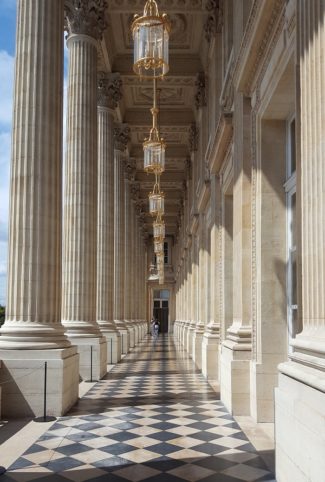
There were only two intendants of the Garde-Meuble over the Louis XV-Louis XVI period that the institution was headquartered here: the intellectual, libertine Pierre-Elisabeth de Fontanieu (from 1772 to 1784) and the more conventional and less imaginative Marc-Antoine Thierry de Ville-d’Avray (from 1784 to 1789), the latter killed during the Revolution. Both left their mark on their private apartments, which were royally furnished and located above the ground-floor storerooms. Painstakingly restored, the human-size living space and offices occupied by these two upper-management bureaucrats are the primary rooms that one visits here while wearing a well-fitting headset through which you learn about their lives and times, major historical events and especially the décor.
Visitors can crab-walk through the narrow, mirrored love-nest created by Fontanieu (though the erotica was later replaced with playful cherubs) and the airy, ostentatious bedrooms later created for Ville-d’Avray and his wife. Electric “candlelight” adds to the charm of these rooms, though the electric cords drooping from the faux candles refutes some of that charm.
The necessary and instructive audio tour is upbeat enough to engage the listener, while the rooms themselves are presented as though still occupied: the dining room table is littered with oyster shells, as it would be after an intimate, upper-class dinner; the gaming tables are cluttered with cards and betting tokens, and the office desks are swamped by paperwork, ledgers and teacups. Beyond the living quarters, the eye is further treated to the gilt decorative work and large chandeliers of galleries subsequently used as ballrooms by Napoleon I, Charles X and Napoleon III, given life during the tour through video recreations of dances past.
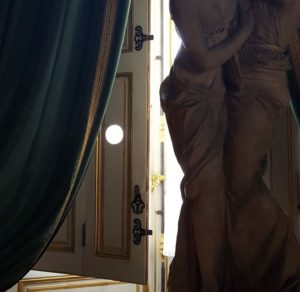
This slice-of-life scenery is possible only after years of treasure hunts for authentic furnishings and period fabrics. Curators and private donors have scooped up past inventory at private auctions. The dining room furniture appropriated by former president Giscard d’Estaing has been returned from the Elysée Palace by President Emmanuel Macron. Visitors from Boston may recognize the Ville-d’Avray bedroom furniture since some of the original furnishings are now in their local museum. WWII buffs will note in that bedroom the hole in the inner shutter that was made by the German occupiers (the German Navy commandeered the building from 1940 to 1944) to watch out for the arrival of liberating forces on Rue de Rivoli in August 1944.
Toward the end of the visit one steps out onto the terrace behind the building’s signature colonnade for a panoramic view of Place de la Concorde and monuments beyond it: the Grand Palais, the Eiffel Tower, the National Assembly, the dome of the Invalides, the greenery of the Tuileries Garden—a view that’s nearly worth the price of admission itself.
Because, yes, there is a cost to this decorative time travel: 13€ for the 45-minute Salon & Loggia tour (with headset) that gives access to the ceremonial rooms and the panoramic view or 17€ for a 90-minute Grand Tour (with headset) which additionally includes the living quarters and private offices, a dozen rooms in all. (Free for visitors under 25.) The indicated times are those of the full audio (available in English) but you aren’t required to stay in each room to examine each decorative item. Seventy minutes or so is a more likely time for the Grand Tour.
Given the choice, we suggest springing for the Grand Tour, in which you have a choice between the following themes: The Age of Enlightenment (i.e. the 18th century), Traveling through Time, and two Family themes, one for adults and one for children. Unless visiting with children (who may find the museum a yawn anyway) and unless you’re particularly interested in 18th history and decorative arts, choose Travelling through Time, which nevertheless gives plenty of information about the 18th century and the décor. Timed reservations are mandatory and help avoid over-crowding of the smaller rooms.
While the colonnade of the Hôtel de la Marine has for 250 years been part of the Parisian landscape, the possibility for the public to now go inside for a view of its splendor is a welcome addition to the city’s museumscape.
The caféscape of Paris also benefits from the opening of Café Lapérouse, named for an 18th-century marine officer and explorer (and a famous restaurant across the river). It’s a fine, chic and pricey port to weigh anchor at any time of day, whether for a morning croissant (3€) or a lobster salad sandwich (35€) or a croque-monsieur (24€) or a late afternoon drink. A ticket to the museum isn’t necessary to enter the café, the courtyard or the gift shop.
The formal restaurant, La Mimosa, directed by multi-starred chef Jean-François Piège, will open in September. According to advance press, it will have a Southern-French influence and France’s first devilled egg bar.
The State’s Centre des Monuments Nationaux, which operates the building, has also made a 20-year deal with the Qatari Al Thani family to present its art collection in the Hôtel de la Marine. The inaugural show will open in the fall.
Hôtel de la Marine, 2 place de la Concorde, 8th arrondissement. Metro: Concorde. Open daily 10:30 am – 7:00 pm; Fridays until 10 pm.
© 2021, Corinne LaBalme and Gary Lee Kraut.

